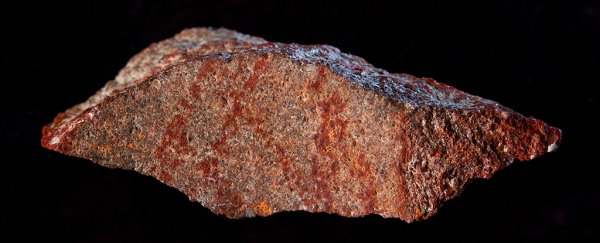Several hundred kilometres to the east of what is today Cape Town, South Africa, stands one of the world's oldest art galleries. The cave is already known for ancient inscriptions, but one art-piece discovered back in 2011 stands out from the rest.
It consists of a handful of intersecting red lines on the side of a flake of stone - think the ubiquitous 'hashtag' symbol, also known as an octothorpe. Simple, but whatever its creator was expressing when they made it 73,000 years ago, it now represents the oldest example of a human drawing. In crayon.
Anthropologists have been digging around in Blombos Cave since the early 1990s, uncovering bones, shell beads, pieces of ochre and other small stones engraved with parallel and zig-zagging lines.
The sediment in the cave represents 100,000 years of history, meaning those who inscribed the lines existed at a time when modern human culture – consisting of art and complex social ritual – was thought to be emerging.
Older human-scratched objects exist, dating as far back as 300,000 years.
But unlike the multitude of engraved items in Blombos Cave, there just isn't enough detail to really get insight into the artist's intentions, leaving it open to debate whether those really ancient lines represent true art or incidental handiwork.
Blombos Cave's etchings are therefore considered to be the oldest examples of symbolic marks, scratched with purpose and meaning. Not that we know what that meaning was at all.
Yet they were all made roughly the same way, by gouging out thin lines of material with a harder object.
With the discovery of a single wedge of sandstone held together by silica – a rock known as silcrete – this all changed.
The silcrete flake had been ground to create a flat, smooth surface. It formed the canvas for a cross-hatched pattern, one we might today recognise as resembling a #.
That grid of six-by-three lines hadn't been etched though. It seemed as if somebody had drawn them in red ochre, which would make it the oldest example of a symbol produced using a transferable medium.
To determine exactly how the lines were inscribed, an international team of anthropologists conducted an experiment.
A close analysis determined the alleged drawing was probably part of a larger, more complex pattern, one that extended away from the fragment of silcrete.
They set out to replicate the exact features of the markings on clean pieces of silcrete from the area, using pieces of ochre with either narrow points or flat edges, or with an ochre 'paint'.
Comparing their own art pieces with the original, the team determined it was unlikely the marks were painted, but were instead left by a 'crayon' of ochre shaved to a point just 1 to 3 millimetres wide (about 1/10th of an inch).
This discovery pushes back the age of pigment-based symbolic art by Homo sapiens by around 30,000 years.
There's evidence Neanderthals might have used ochre to draw on cave walls roughly 64,000 years ago, but until now the earliest examples of our own handiwork date back to little more than 40,000 years.
Being the oldest example doesn't mean this rock was humanity's first attempt at drawing. For one thing, etchings do a much better job surviving the ages.
There are also reasons to suspect ochre had been processed at Blombos Cave for some sort of ritualistic or artistic purpose for at least 30,000 years prior to this stone's inscription.
This simple design does represent a landmark for human culture, though, providing concrete evidence that we've been both creating less permanent art pieces for almost as long as we've been engraving objects.
As to what the symbol might mean, that really is anybody's guess. The octothorpe symbol we call a hashtag today actually has a long history as the number sign or hash, and has represented everything from a quantity to a checkmate move in chess.
Whether such hatching inscriptions denoted ownership in ancient times, held superstitious meaning, or were just aesthetically pleasing, it's impossible to say.
Whatever it is, we've been doodling it for a long time.
This research was published in Nature.
